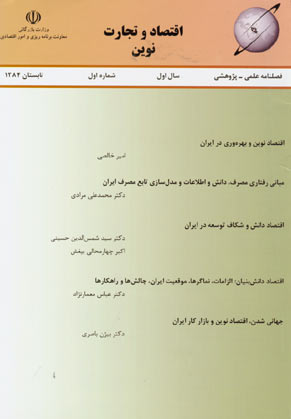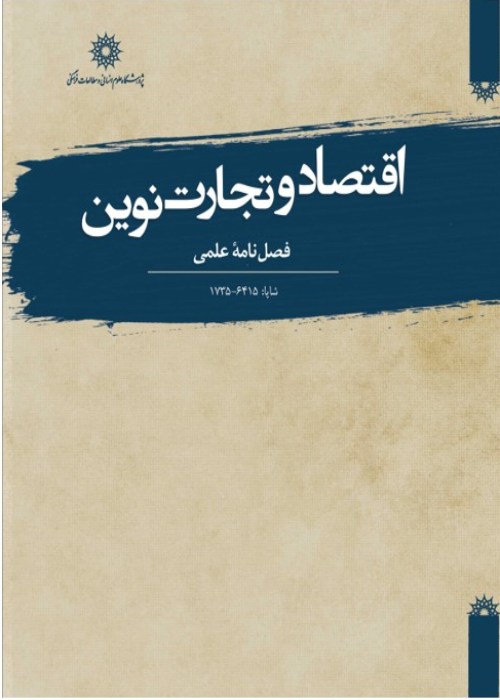فهرست مطالب

نشریه اقتصاد و تجارت نوین
پیاپی 1 (تابستان 1384)
- 131 صفحه، بهای روی جلد: 5,000ريال
- تاریخ انتشار: 1384/05/26
- تعداد عناوین: 7
-
صفحه 1در این مقاله رابطه بین اقتصاد نوین و بهره وری کل عوامل بررسی می شود. به عبارت دیگر، نقش مولفه های مهم اقتصاد نوین و سایر عوامل تعیین کننده در رشد بهره وری کل را توضیح داده و با توجه به مولفه های یاد شده، راه های ارتقای بهره وری کل عوامل پیشنهاد می شود. بدین منظور ابتدا بهره وری کل عوامل از تلفیق دو رویکرد حسابداری رشد و تخمین تابع تولید با بکارگیری تکنیک های اقتصاد سنجی، محاسبه و سپس رابطه بین مولفه های اقتصاد نوین نظیر تحقیق و توسعه، سرمایه گذاری مستقیم خارجی، درجه باز بودن اقتصاد و سایر متغیرها مانند تورم و تغییرات ساختاری با بهره وری کل عوامل با استفاده از تکنیک همجمعی برای دوره زمانی 1382 1338، مورد بررسی قرار می گیرد. ...
کلیدواژگان: اقتصاد نوین، بهره وری کل عوامل، تحقیق و توسعه، درجه باز بودن اقتصاد، همجمعی، ایران -
صفحه 20هدف این مقاله تبیین رفتار مصرفی افراد در چارچوب تابع مصرف خصوصی سرانه ایران است. برای مدل سازی تابع مصرف در ادبیات اقتصادی دو روش وجود دارد. روش اول مبتنی بر استخراج و تخمین معادله اولر است و روش دوم بر اساس شناسایی عوامل موثر بر مصرف، استوار است. این مقاله با تاکید بر نقش دانش و اطلاعات نشان می دهد که روش اول برای مطالعات تجربی با نارسایی های جدی مواجه است، لذا روش دوم برای تحلیل رفتار مصرفی کشور انتخاب می گردد. ...
کلیدواژگان: رفتار مصرفی، دانش و اطلاعات، همجمعی، مدل سازی خطی و غیر خطی مصرف، ایران -
صفحه 55از میان بردن شکاف توسعه هدف اصلی برنامه ریزی برای کشورهای در حال توسعه همچون ایران است. نکته حائز اهمیت در این راستا، درک این نکته است که نه تنها اندازه، بلکه ماهیت شکاف توسعه، برای کشورها و یا حتی برای یک کشور در دوره های مختلف متفاوت است. مقاله حاضر در این چارچوب و با هدف ارزیابی شکاف توسعه ایران در فضای اقتصاد دانش نوشته شده است. به این منظور علاوه بر این که شرایط اقتصادهای دانش با اقتصادهای سنتی مقایسه شده اند، مفهوم شکاف ایده یا دانش (شکاف توسعه در اقتصاد نوین) و شکاف عوامل (شکاف سنتی توسعه) نیز بیان شده اند. ...
کلیدواژگان: اقتصاد دانش (دانایی)، توسعه دانش بر، روش شناسی ارزیابی اقتصاد دانش (KAM)، شکاف توسعه ایران -
صفحه 83نقش علم و دانش در اقتصاد به دلیل ایجاد تخصص و بهبود بهره وری عوامل تولید از گذشته مورد توجه قرار گرفته و جایگاه فناوری و دانش به عنوان عوامل درون زا در رشد اقتصادی مورد تاکید قرار گرفته است. با توجه به این که در اقتصاد دانش بنیان، تولید، توزیع و کاربرد دانش و اطلاعات عامل و محرک اصلی رشد اقتصادی، تولید ثروت و اشتغال در تمامی فعالیت های اقتصادی است، فرایندهای خلق و ایجاد دانش، فراگیری و اکتساب آن، پخش و اشاعه و کاربرد عملی آن باید به دقت برنامه ریزی تا بازخورد بین فرایندهای مذکور، پیشرفت اقتصاد دانش بنیان را تضمین می کند. ...
کلیدواژگان: اقتصاد دانش بنیان، علم و دانش، نماگرهای اقتصاد دانش بنیان، مقایسه تطبیقی کشورها، ایران -
صفحه 110پژوهش حاضر بر آن است تا تاثیر جهانی شدن را به عنوان بخشی از اقتصاد نوین بر بازار کار مورد مطالعه قرار دهد. جهانی شدن فرایند یکپارچگی اقتصادی در گذر شتابان زمان است و به دلیل همگرایی ساختارها و افزایش همکاری های اقتصادی در سطح بین الملل، تعامل گسترده ای را میان افراد، نهادهای اقتصادی و اجتماعی و دولت ها به وجود آورده است. بازارها در فرایند جهانی شدن تحت تاثیر یکدیگر دستخوش تغییر می شوند. فرضیه مطالعه حاضر آن است که جهانی شدن ساختار بازار کار در ایران را به شکل مثبتی تحت تاثیر قرار می دهد. ...
کلیدواژگان: جهانی شدن، بازار کار، اشتغال، اقتصاد نوین، ایران -
راهنمای نویسندگانصفحه 128
-
چکیده انگلیسیصفحه 132
-
Page 1This paper studies the relationship between the components of new economy and total factor productivity (TFP) in Iran using annual data over the period 1959 - 2003. A translog flexible production function is specified and estimated in order to compute the total factor productivity. Then the effects of the components of new economy such as Research and Development (R&D), FDI, openness, the rate of inflation, capital, and structural change on the TFP growth are investigated using the cointegration VAR approach. The findings show that R&D, openness, and capital affect positively TFP growth and the rate of inflation and structural change affect negatively on TFP growth. Furthermore, the components of new economy such as R&D and openness of the economy are the major determinants of the TFP growth in the economy.Keywords: New Economy, Total Factor Productivity, Cointegration, Ir
-
Page 20This article investigates private consumption behavior in Iran using annual data over the period 1959 2003. There are two approaches in modeling consumption function. First approach is based on the Euler equation while the second approach aims to identify the main determinants of consumption. One interpretation of the two approaches is that Euler equation test just theories, while the second approach is designed to answer different questions, primarily about the role of different variables in the consumption function. Derivation of Euler equation is based on rather strange assumptions when it comes to explaining process of knowledge, information, and long-term change. Since this approach takes no account of imperfect information and unstable preferences, the second approach is considered to model the consumer behavior in Iran. A linear model is specified and estimated and then due to the rejection of linearity, a nonlinear process is used as a plausible specification of consumption function. Smooth transition regression (STAR) models are used to model consumption function. The null hypothesis of linearity is rejected in favor of the logistic STAR (LSTAR) specification. The results show that the long run determinants of the private consumption in Iran are disposable income, wealth, and the rate of inflation. Moreover, findings show that the lack of sufficient knowledge and information of consumer is one of the determinants of inertia behavior of consumer in Iran. Moreover, the estimate of transition parameter in nonlinear model indicates that the speed of transition from one regime to another is quite smooth and gradual. While the assumption of the equilibrium term makes the linear model unbalanced, a LSTAR model specification yields a balance equation. Therefore, the empirical evidence suggesting that modeling of consumption is in favor of nonlinear rather than linear.Keywords: Consumption Behavior, Knowledge, Information, Cointegration, Modeling linear, Nonlinear Consumption Function, Iran
-
Page 55The main objective of planning is to remove |"Development Gap" in developing countries such as Iran. In this respect, the noteworthy point to be considered is not only the size of Development Gap, but also its components, which is different among countries or even for a country in different eras. This article aims to assess Iran’s Development Gap in the context of Knowledge Economy. In addition, it compares the status of Knowledge Economies with traditional ones. The definition of Idea or Knowledge Gap, as a Development Gap in modern economies, is clarified versus Objects Gap, as a traditional Development Gap. Then the components of Development Gap in Iran’s economy are examined with respect to some selected countries. The findings shows that Iran’s economy is not faced with the lack of natural, financial and human resources. Therefore, it can be concluded that Objects Gap is not an issue for Iran. However, based on the results of Knowledge Assessment Methodology (KAM), it is concluded that the Iranian economy is faced with some gap concerning Knowledge indices. The examinations of Knowledge Economy Indicators show that Iran’s economy has experienced poor output performance, while there has been proper inputs and high capacity of Knowledge in the country. This poor performance can be mainly explained by the low quality of rules and regulations, high rate of risk, etc. Finally, it is recommended that the findings of the study should be taken to account for implicating the Iran’s Twenty Year Vision Plan in order to achieve the highest economic Position in Southern West Asia.Keywords: Knowledge Economy, Development Gap, Knowledge Assessment Methodology (KAM), Comparative Studies of Countries, Iran
-
Page 83For a long time, economists have recognized only three factors of production; labor, fiscal capital, and natural resources. Recent decades, this view has gradually changed. Information and knowledge are now replacing traditional factors of production as the primary wealth-creating assets. In addition, technological developments in the 20th century have transformed the majority of wealth-creating work from physically-based to "knowledge-based". Countries use knowledge to strengthen their competitiveness in the global economy and increase their social well-being. So, knowledge and technology are now the key factors of production and they are known as drivers of productivity, economic growth, and development. Knowledge based economy (KBE) dwells on the importance of education, innovation and technological adoption, ICT infrastructure, human resource, and the economic and institutional regime, and their interdependence, for sustained economic growth. KBE indices are divided into four groups; innovation system, business environment, information and communication technology (ICT), and human resource development. This paper employed recent data for Iran to exam the components of the KBE using various indices. Moreover, comparative studies have been done for some selected countries. The findings of the study show that the performance of Iran is not satisfactory. In the international comparative terms, there is a big gap between Iran and other selected countries. Therefore, Iran needs to design a consistent policy package to fill the gap.Keywords: Knowledge Based Economy (KBE), KBE Indices, Comparative Studies of Countries, Iran
-
Page 110This paper aims to examine the impacts of globalization on the employment in the framework of new economy using Iranian annual data over the period 1959 – 2002. Globalization has been associated with profound changes in the labor market. It expands labor markets and integrates economies and regulations. More specifically, it affects labor standards such as minimum wages, conditions of work, hire and fire terms, relationship systems, and the nature of bargaining. Consequently, workers and firms need to be more adaptable to improve competitiveness, skills and productivity. The net impact of globalization on employment and unemployment depends on a host of socioeconomic and political factors affecting the processes of liberalization. The findings of the study based on ARDL approach show that the determinants of employment have the expected signs, i.e., positive for real non-oil GDP and openness, negative for the ratio of capital over labor force. Therefore, globalization has positive effect on employment in the Iranian economy. In the short- run as well as in the long-run, the elasticity of labor demand with respect to openness is positive. So, the capacity of job- creating of trade sector as a proxy of globalization is positive.Keywords: Globalization, New Economy, Employment, Openness, Iran


